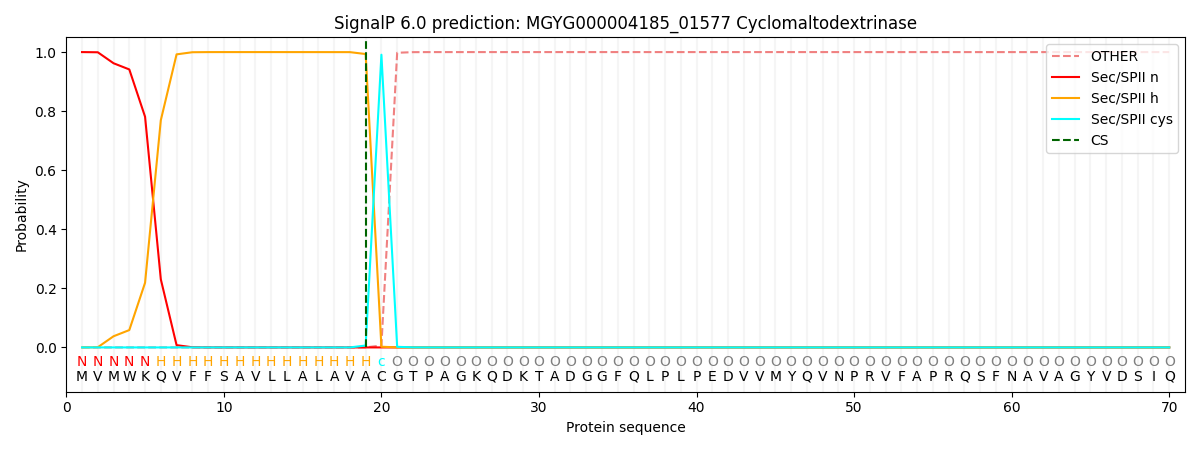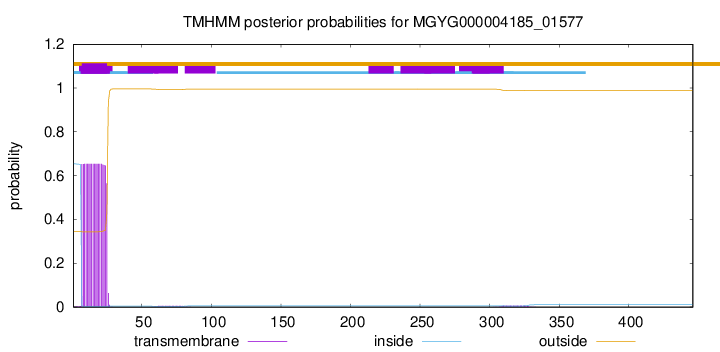You are browsing environment: HUMAN GUT
CAZyme Information: MGYG000004185_01577
You are here: Home > Sequence: MGYG000004185_01577
Basic Information |
Genomic context |
Full Sequence |
Enzyme annotations |
CAZy signature domains |
CDD domains |
CAZyme hits |
PDB hits |
Swiss-Prot hits |
SignalP and Lipop annotations |
TMHMM annotations
Basic Information help
| Species | Bacteroides sp900553815 | |||||||||||
|---|---|---|---|---|---|---|---|---|---|---|---|---|
| Lineage | Bacteria; Bacteroidota; Bacteroidia; Bacteroidales; Bacteroidaceae; Bacteroides; Bacteroides sp900553815 | |||||||||||
| CAZyme ID | MGYG000004185_01577 | |||||||||||
| CAZy Family | GH13 | |||||||||||
| CAZyme Description | Cyclomaltodextrinase | |||||||||||
| CAZyme Property |
|
|||||||||||
| Genome Property |
|
|||||||||||
| Gene Location | Start: 9648; End: 10988 Strand: - | |||||||||||
CAZyme Signature Domains help
| Family | Start | End | Evalue | family coverage |
|---|---|---|---|---|
| GH13 | 54 | 335 | 5.6e-46 | 0.939799331103679 |
CDD Domains download full data without filtering help
| Cdd ID | Domain | E-Value | qStart | qEnd | sStart | sEnd | Domain Description |
|---|---|---|---|---|---|---|---|
| cd11313 | AmyAc_arch_bac_AmyA | 6.84e-139 | 41 | 373 | 3 | 336 | Alpha amylase catalytic domain found in archaeal and bacterial Alpha-amylases (also called 1,4-alpha-D-glucan-4-glucanohydrolase). AmyA (EC 3.2.1.1) catalyzes the hydrolysis of alpha-(1,4) glycosidic linkages of glycogen, starch, related polysaccharides, and some oligosaccharides. This group includes firmicutes, bacteroidetes, and proteobacteria. The Alpha-amylase family comprises the largest family of glycoside hydrolases (GH), with the majority of enzymes acting on starch, glycogen, and related oligo- and polysaccharides. These proteins catalyze the transformation of alpha-1,4 and alpha-1,6 glucosidic linkages with retention of the anomeric center. The protein is described as having 3 domains: A, B, C. A is a (beta/alpha) 8-barrel; B is a loop between the beta 3 strand and alpha 3 helix of A; C is the C-terminal extension characterized by a Greek key. The majority of the enzymes have an active site cleft found between domains A and B where a triad of catalytic residues (Asp, Glu and Asp) performs catalysis. Other members of this family have lost the catalytic activity as in the case of the human 4F2hc, or only have 2 residues that serve as the catalytic nucleophile and the acid/base, such as Thermus A4 beta-galactosidase with 2 Glu residues (GH42) and human alpha-galactosidase with 2 Asp residues (GH31). The family members are quite extensive and include: alpha amylase, maltosyltransferase, cyclodextrin glycotransferase, maltogenic amylase, neopullulanase, isoamylase, 1,4-alpha-D-glucan maltotetrahydrolase, 4-alpha-glucotransferase, oligo-1,6-glucosidase, amylosucrase, sucrose phosphorylase, and amylomaltase. |
| cd00551 | AmyAc_family | 2.53e-33 | 44 | 326 | 1 | 252 | Alpha amylase catalytic domain family. The Alpha-amylase family comprises the largest family of glycoside hydrolases (GH), with the majority of enzymes acting on starch, glycogen, and related oligo- and polysaccharides. These proteins catalyze the transformation of alpha-1,4 and alpha-1,6 glucosidic linkages with retention of the anomeric center. The protein is described as having 3 domains: A, B, C. A is a (beta/alpha) 8-barrel; B is a loop between the beta 3 strand and alpha 3 helix of A; and C is the C-terminal extension characterized by a Greek key. The majority of the enzymes have an active site cleft found between domains A and B where a triad of catalytic residues (Asp, Glu and Asp) performs catalysis. Other members of this family have lost this catalytic activity as in the case of the human 4F2hc, or only have 2 residues that serve as the catalytic nucleophile and the acid/base, such as Thermus A4 beta-galactosidase with 2 Glu residues (GH42) and human alpha-galactosidase with 2 Asp residues (GH31). The family members are quite extensive and include: alpha amylase, maltosyltransferase, cyclodextrin glycotransferase, maltogenic amylase, neopullulanase, isoamylase, 1,4-alpha-D-glucan maltotetrahydrolase, 4-alpha-glucotransferase, oligo-1,6-glucosidase, amylosucrase, sucrose phosphorylase, and amylomaltase. |
| cd11316 | AmyAc_bac2_AmyA | 3.00e-33 | 59 | 334 | 22 | 334 | Alpha amylase catalytic domain found in bacterial Alpha-amylases (also called 1,4-alpha-D-glucan-4-glucanohydrolase). AmyA (EC 3.2.1.1) catalyzes the hydrolysis of alpha-(1,4) glycosidic linkages of glycogen, starch, related polysaccharides, and some oligosaccharides. This group includes Chloroflexi, Dictyoglomi, and Fusobacteria. The Alpha-amylase family comprises the largest family of glycoside hydrolases (GH), with the majority of enzymes acting on starch, glycogen, and related oligo- and polysaccharides. These proteins catalyze the transformation of alpha-1,4 and alpha-1,6 glucosidic linkages with retention of the anomeric center. The protein is described as having 3 domains: A, B, C. A is a (beta/alpha) 8-barrel; B is a loop between the beta 3 strand and alpha 3 helix of A; C is the C-terminal extension characterized by a Greek key. The majority of the enzymes have an active site cleft found between domains A and B where a triad of catalytic residues (Asp, Glu and Asp) performs catalysis. Other members of this family have lost the catalytic activity as in the case of the human 4F2hc, or only have 2 residues that serve as the catalytic nucleophile and the acid/base, such as Thermus A4 beta-galactosidase with 2 Glu residues (GH42) and human alpha-galactosidase with 2 Asp residues (GH31). The family members are quite extensive and include: alpha amylase, maltosyltransferase, cyclodextrin glycotransferase, maltogenic amylase, neopullulanase, isoamylase, 1,4-alpha-D-glucan maltotetrahydrolase, 4-alpha-glucotransferase, oligo-1,6-glucosidase, amylosucrase, sucrose phosphorylase, and amylomaltase. |
| cd11349 | AmyAc_3 | 8.39e-28 | 43 | 332 | 1 | 391 | Alpha amylase catalytic domain found in an uncharacterized protein family. The Alpha-amylase family comprises the largest family of glycoside hydrolases (GH), with the majority of enzymes acting on starch, glycogen, and related oligo- and polysaccharides. These proteins catalyze the transformation of alpha-1,4 and alpha-1,6 glucosidic linkages with retention of the anomeric center. The protein is described as having 3 domains: A, B, C. A is a (beta/alpha) 8-barrel; B is a loop between the beta 3 strand and alpha 3 helix of A; C is the C-terminal extension characterized by a Greek key. The majority of the enzymes have an active site cleft found between domains A and B where a triad of catalytic residues (Asp, Glu and Asp) performs catalysis. Other members of this family have lost the catalytic activity as in the case of the human 4F2hc, or only have 2 residues that serve as the catalytic nucleophile and the acid/base, such as Thermus A4 beta-galactosidase with 2 Glu residues (GH42) and human alpha-galactosidase with 2 Asp residues (GH31). The family members are quite extensive and include: alpha amylase, maltosyltransferase, cyclodextrin glycotransferase, maltogenic amylase, neopullulanase, isoamylase, 1,4-alpha-D-glucan maltotetrahydrolase, 4-alpha-glucotransferase, oligo-1,6-glucosidase, amylosucrase, sucrose phosphorylase, and amylomaltase. |
| cd11334 | AmyAc_TreS | 1.69e-26 | 41 | 231 | 3 | 238 | Alpha amylase catalytic domain found in Trehalose synthetase. Trehalose synthetase (TreS) catalyzes the reversible interconversion of trehalose and maltose. The enzyme catalyzes the reaction in both directions, but the preferred substrate is maltose. Glucose is formed as a by-product of this reaction. It is believed that the catalytic mechanism may involve the cutting of the incoming disaccharide and transfer of a glucose to an enzyme-bound glucose. This enzyme also catalyzes production of a glucosamine disaccharide from maltose and glucosamine. The Alpha-amylase family comprises the largest family of glycoside hydrolases (GH), with the majority of enzymes acting on starch, glycogen, and related oligo- and polysaccharides. These proteins catalyze the transformation of alpha-1,4 and alpha-1,6 glucosidic linkages with retention of the anomeric center. The protein is described as having 3 domains: A, B, C. A is a (beta/alpha) 8-barrel; B is a loop between the beta 3 strand and alpha 3 helix of A; C is the C-terminal extension characterized by a Greek key. The majority of the enzymes have an active site cleft found between domains A and B where a triad of catalytic residues (Asp, Glu and Asp) performs catalysis. Other members of this family have lost the catalytic activity as in the case of the human 4F2hc, or only have 2 residues that serve as the catalytic nucleophile and the acid/base, such as Thermus A4 beta-galactosidase with 2 Glu residues (GH42) and human alpha-galactosidase with 2 Asp residues (GH31). The family members are quite extensive and include: alpha amylase, maltosyltransferase, cyclodextrin glycotransferase, maltogenic amylase, neopullulanase, isoamylase, 1,4-alpha-D-glucan maltotetrahydrolase, 4-alpha-glucotransferase, oligo-1,6-glucosidase, amylosucrase, sucrose phosphorylase, and amylomaltase. |
CAZyme Hits help
| Hit ID | E-Value | Query Start | Query End | Hit Start | Hit End |
|---|---|---|---|---|---|
| QUT89273.1 | 2.34e-220 | 5 | 446 | 2 | 441 |
| ALJ59675.1 | 1.91e-219 | 5 | 446 | 2 | 441 |
| QDO68033.1 | 5.47e-219 | 5 | 446 | 2 | 441 |
| QUT35519.1 | 1.53e-192 | 5 | 446 | 2 | 441 |
| QBJ19369.1 | 1.53e-192 | 5 | 446 | 2 | 441 |
PDB Hits download full data without filtering help
| Hit ID | E-Value | Query Start | Query End | Hit Start | Hit End | Description |
|---|---|---|---|---|---|---|
| 3DHU_A | 1.86e-39 | 44 | 330 | 14 | 313 | Crystalstructure of an alpha-amylase from Lactobacillus plantarum [Lactiplantibacillus plantarum],3DHU_B Crystal structure of an alpha-amylase from Lactobacillus plantarum [Lactiplantibacillus plantarum],3DHU_C Crystal structure of an alpha-amylase from Lactobacillus plantarum [Lactiplantibacillus plantarum],3DHU_D Crystal structure of an alpha-amylase from Lactobacillus plantarum [Lactiplantibacillus plantarum] |
| 4GKL_A | 1.51e-37 | 41 | 340 | 4 | 301 | Crystalstructure of a noncanonic maltogenic alpha-amylase AmyB from Thermotoga neapolitana [Thermotoga neapolitana],4GKL_B Crystal structure of a noncanonic maltogenic alpha-amylase AmyB from Thermotoga neapolitana [Thermotoga neapolitana] |
| 4E2O_A | 5.27e-24 | 62 | 442 | 47 | 451 | Crystalstructure of alpha-amylase from Geobacillus thermoleovorans, GTA, complexed with acarbose [Geobacillus thermoleovorans CCB_US3_UF5] |
| 5A2A_A | 2.63e-22 | 66 | 413 | 50 | 411 | CrystalStructure of Anoxybacillus Alpha-amylase Provides Insights into a New Glycosyl Hydrolase Subclass [Anoxybacillus ayderensis] |
| 5A2B_A | 3.43e-22 | 66 | 413 | 84 | 445 | CrystalStructure of Anoxybacillus Alpha-amylase Provides Insights into a New Glycosyl Hydrolase Subclass [Anoxybacillus ayderensis],5A2C_A Crystal Structure of Anoxybacillus Alpha-amylase Provides Insights into a New Glycosyl Hydrolase Subclass [Anoxybacillus ayderensis] |
Swiss-Prot Hits download full data without filtering help
| Hit ID | E-Value | Query Start | Query End | Hit Start | Hit End | Description |
|---|---|---|---|---|---|---|
| L8B068 | 1.52e-24 | 41 | 411 | 246 | 622 | Alpha-amylase MalA OS=Haloarcula japonica (strain ATCC 49778 / DSM 6131 / JCM 7785 / NBRC 101032 / NCIMB 13157 / TR-1) OX=1227453 GN=malA PE=1 SV=1 |
| Q08341 | 1.80e-23 | 62 | 444 | 176 | 582 | Cyclomaltodextrinase OS=Lysinibacillus sphaericus OX=1421 PE=1 SV=1 |
| O34364 | 1.88e-20 | 41 | 201 | 7 | 199 | Probable oligo-1,6-glucosidase 2 OS=Bacillus subtilis (strain 168) OX=224308 GN=ycdG PE=2 SV=1 |
| P31797 | 5.85e-20 | 72 | 400 | 97 | 462 | Cyclomaltodextrin glucanotransferase OS=Geobacillus stearothermophilus OX=1422 GN=cgt PE=1 SV=1 |
| P14898 | 3.47e-19 | 58 | 416 | 164 | 536 | Alpha-amylase 2 OS=Dictyoglomus thermophilum (strain ATCC 35947 / DSM 3960 / H-6-12) OX=309799 GN=amyB PE=1 SV=2 |
SignalP and Lipop Annotations help
This protein is predicted as LIPO

| Other | SP_Sec_SPI | LIPO_Sec_SPII | TAT_Tat_SPI | TATLIP_Sec_SPII | PILIN_Sec_SPIII |
|---|---|---|---|---|---|
| 0.000000 | 0.000001 | 1.000047 | 0.000000 | 0.000000 | 0.000000 |

